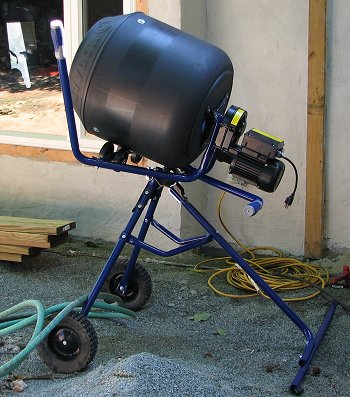Tag: choosing a cement mixer
Stucco Series – The Cement Mixer Decision
by admin on Nov.14, 2011, under Favorites, Images, Real Estate
Cement questions to ask yourself…how much do you need, and how much can you properly manage?

While the cement for the paver stones shown on prior posts was mixed by hand, the desire for a concrete slab near the new back door meant more and faster concrete production would be required.
Time to ponder a cement mixer.
Although most portable cement mixers are rated between 3 and 5 cubic feet we found our actual batch sizes were typically about 2 cubic feet or 3 bags of Quikcrete.
To put this in perspective, a 4-foot square of sidewalk, 6 inches thick, requires 8 cubic feet (4′ x 4′ x 1/2′) or 12 bags of Quikcrete. You can see that even a small concrete slab takes a surprising amount of cement – and work.
If you’re looking at a driveway or patio, hire the ready-mix truck to come in and pour your concrete. We did not have that option here since no local truck having the pumping capability, in this instance – long distance from the main street, was available.
Your first online research may have you believing you’ll need to spend $1500+ for a cement mixer. Not true.
We selected the Kobalt 4 cu ft Multi-Use Portable Mixer from Lowe’s. It has a 235lb mixing weight and a 2.3 cubic foot mixing capacity. This is about all a 2-person crew can manage.
The lightweight plastic drum will be both durable and easy to clean. The 1/2 hp electric weatherproof motor was sufficiently powerful to mix the cement batches we needed. Knowing this was a once-in-awhile use item, the $350 +/- price tag seemed acceptable.
You’ll need to have an assembly-line plan to complete this project. Multiple mixes, spins of the cement mixer, pours, finishing, start the next batch, and over, and over. In this case, an extra pair of hands or two will be welcomed.
The other time-consuming part of this task is concrete finishing. It is not as easy as professionals make it look. Start with a small area and work it until it is as smooth and level as you can possibly make it. This finishing skill does seem to get better the more you do – like so many other DIY challenges. But with concrete pours, you just need to learn and improve quickly!
Plan on spending 30 minutes plus cleaning the unit after use if you want to be able to ever use it again! Once concrete dries, it stays!

